Interprofessional Education report on the 2023-2024 Academic Year
The IPE program began early this year when the IPE team was allotted a 45-minute block of time during new student orientation. This allowed the team to introduce the concept and talk about the engaging activities to come. The goal was to introduce the fact that students in seven different programs all belong to our large IPE community!
Once the fall session started, we jumped right into action. Here are just some of the IPE activities that were implemented this academic year.
Activity 1; Role Clarification 1.0; First-year, first-semester students from Physiotherapy Technology, Medical Ultrasound, Radiation Oncology, Diagnostic Imaging
The aim of this activity was to have students from the above 4 disciplines learn about other professions’ roles. This allowed students to understand similarities and differences between professions, to appreciate each profession’s role, and to better communicate with other disciplines when they are working in the field. In interdisciplinary groups, students toured different disciplines’ labs to experience a day in the life of each profession. They also filled out a collaborative document to learn about the expertise of each discipline and when another discipline’s expertise was needed in patient care. Since this activity takes place in the first semester, this was the first time that students participated in interdisciplinary activities. It was a great introduction to the IPE community.
Activity 2: Motivational Interviewing: Physiotherapy Technology and Social Service
The aim of this activity was for Physiotherapy Technology and Social Service students to collaborate and use motivational interviewing skills to move an at-risk client to another stage of change. This allowed students to learn effective team dynamics and how to work together to motivate change in a client. In teams, students considered the at-risk client’s issues including physical, health, and daily life. They then completed a role play activity using motivational interviewing skills to help move this client to change.
Activity 3: The Sarah Lynn Breast Cancer Case
This activity was embedded into all seven programs’ courses in their third semesters. The students viewed a mocumentary of Sarah Lynn’s breast cancer journey. The video creates a timeline of how she encounters each of the seven disciplines. The students were then tasked with creating short videos that explained the techniques, technology, and treatment approaches one would take to care for Sarah Lynn. The students were then instructed to watch one video from each discipline to get a more holistic understanding of a patient’s journey.
Patricia, a teacher in the Nursing program, said that “the case study was so beneficial because it really does make it real for the students. In creating the video, the students were able to evaluate their performance of a skill and some students felt guilty when they realized that they had broken sterility. This activity added a patient context that is not always achievable when using case studies.”
In addition, Peter, a Diagnostic Imaging teacher, commented that “the Sarah Lynn project is igniting the students’ creativity and integrity. This good seed will bear fruit. There will be better cooperation in these students’ future professional life.”
Link to the Sarah Lynn video that all students watched to show the patients journey and that outlines where each discipline fits in the patient’s story: https://youtu.be/ckeztx0mzlk
Activity 4: Third-year Symposium on Communication, Conflict Resolution and Collective Competence
Over 300 students and 30 teachers took part in the second annual IPE symposium in November. The attendees were treated to updated skits written and performed by Dawson Theatre graduates and redesigned student booklets that encouraged engagement in the day’s learning activities. One student mentioned that they “found the skits to be engaging and well suited to the learning objectives of the day” while another stated that “the student booklet provided for the IPE Symposium was an effective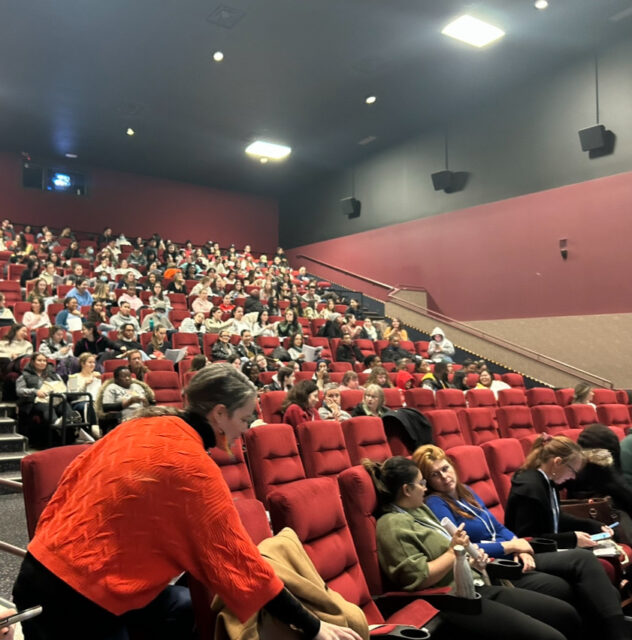 tool for following the plan of the day, reviewing key concepts, and engaging in individual and group exercises and activities”.
tool for following the plan of the day, reviewing key concepts, and engaging in individual and group exercises and activities”.
Overall, the activity was a great success. Students in attendance mentioned that the “the breakout room activities helped them apply the concepts learned in the teaching portions of the day” and they “found that working with students from other health disciplines was stimulating and enriching”. Having tried to mirror a real-life situation, students mentioned that they “found the IPE Symposium to be a valuable learning experience that they will be able to apply in the future.”
A big thank you to the following for making the IPE symposium happen:
- Dawson Foundation Student Academic Enrichment FundDawson College Peace Centre
- Student Success Action Plan
- Sustainable Dawson
- Dawson College Professional Theatre program
Activity 5: Procurement activity with Nursing and Biomedical Lab
The timing and scheduling for this activity worked out perfectly. An IPE activity involving the Nursing and Biomedical Laboratory programs was always an idea and this fall semester was finally the perfect time for it to be implemented. Over 80 students between the two programs took part in the activity!
Daniel, a Biomedical Laboratory teacher summarized the activity beautifully:
“As blood procurement increasingly shifts from medical technologists to other professional groups like nurses, this activity couldn’t have been timelier. It provided an excellent opportunity to share our expertise on the often-overlooked nuances of phlebotomy techniques that can significantly impact sample integrity and result reliability. Additionally, it helped medical technologists gain a better understanding of the realities of the nursing profession.”

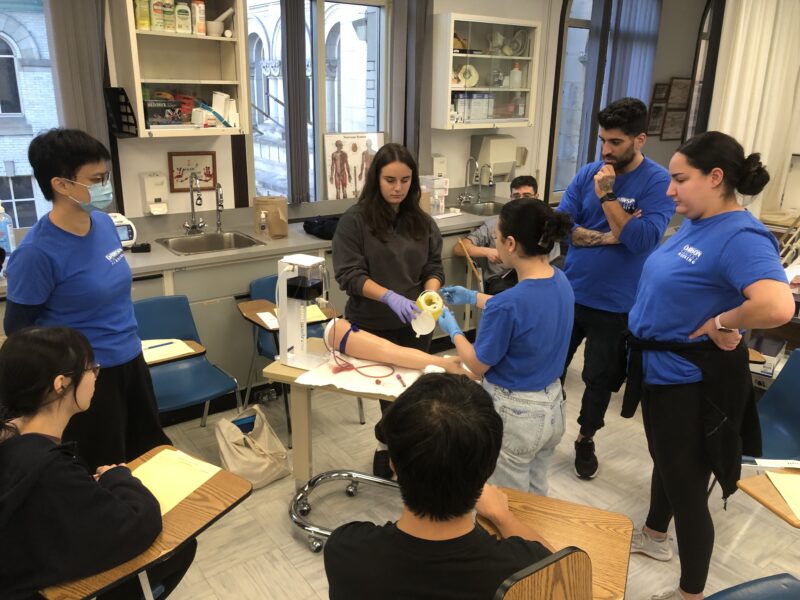
Activity 6. Role Clarification 2.0 involving Social Service and Physiotherapy Technology
Over 70 students and 12 teachers took part in this activity where students were tasked with completing a patient/client interview collaboratively. The overarching goal of the activity was for students to learn the different approaches each discipline takes when gathering information concerning a patient/client. The value of open and closed ended questions and exploring biopsychosocial factors impacting functioning and wellbeing was observed as each patient scenario came with its own challenges. A student from Social Service summarized the activity perfectly by saying that they “found the IPE activity extremely educative! The interrelationship between the professions of Social Service Work and Physiotherapy Technology was evident: how the physical difficulties an individual may be facing correlate directly to their psychological and social well-being.”
Activity 7. Anatomy and Biology consolidation activity: The Cadaver Lab experience: Radiation Oncology, Medical Ultrasound, Physiotherapy Technology
Over 60 students and 10 teachers participated in the cadaver lab activity that took place at Concordia University’s Loyola Campus at the Richard J. Renaud Science Complex Anatomy Lab. Students were able to engage with a:
- Full articulating skeleton
- Full body with UE / LE muscles (superficial)
- Leg / half pelvis
- Arm
- Torso with access to most abdominal organs (removable lungs/liver)
- Head sliced mid-sagittal.
- Head with facial / neck muscles
- Heart and lungs attached.
- Tongue / larynx / trachea with blood vessels
Some students were unsure at first, but all students were instructed to engage with the activity as much as they felt comfortable. Once the one-hour experience ended, many students mentioned that it went too fast and that they would have loved to stay longer. One Physiotherapy Technology student expressed that he “really enjoyed the cadaver activity, it allowed me to get a clear look at human anatomy and it’s nice to see what we learn in real life. As seeing the muscles, I could really picture how they shortened and lengthening since I’m more of a visual learner. Thank you for this opportunity.”
Activity 9. Teamwork and Communication: Reacting to a medical emergency in the CT Room: Diagnostic Imaging and Radiation Oncology.
Over 45 students, three teachers and two staff members took part in this simulation activity where students from both the Diagnostic Imaging and Radiation Oncology department collaborated on a common course competency: how to deal with an allergic reaction once a contrast agent is administered. Interprofessional student groups engaged in an anaphylactic shock simulation. It was a cumulative learning experience where each IPE group was able to watch the simulation take place in real time. The students that attempted the simulation first were able to learn from their missteps as the other five IPE groups attempted the simulation. Each group that followed were able to take notes and learn from their fellow students’ experiences so that when it was their turn to experience the simulation, they were more informed and organized.
During the debrief of this activity, the common student reflection was that “this activity made us all realize how quickly everything happens and how we really need to be aware of our patient’s body language.” When students were asked if they enjoyed the simulation experience, one Diagnostic Imaging student responded by saying: “I hope we can have many more simulations in the coming years. It was nerve wracking, but it forced us to act and collaborate.”
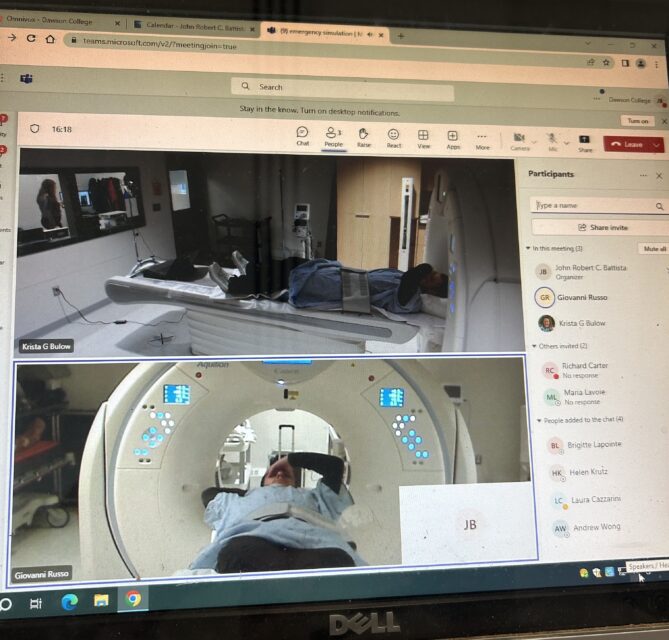
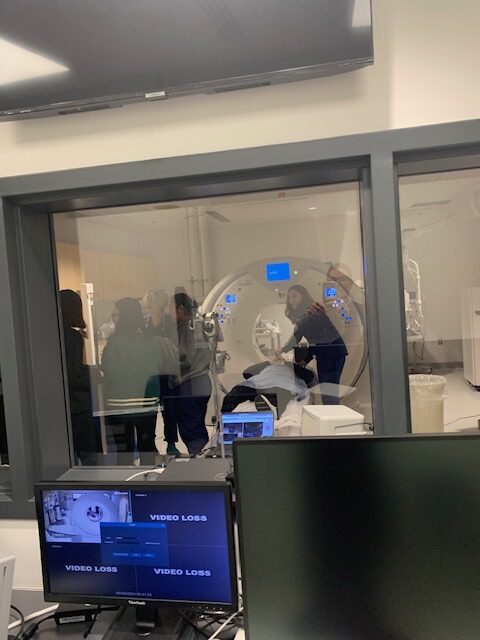
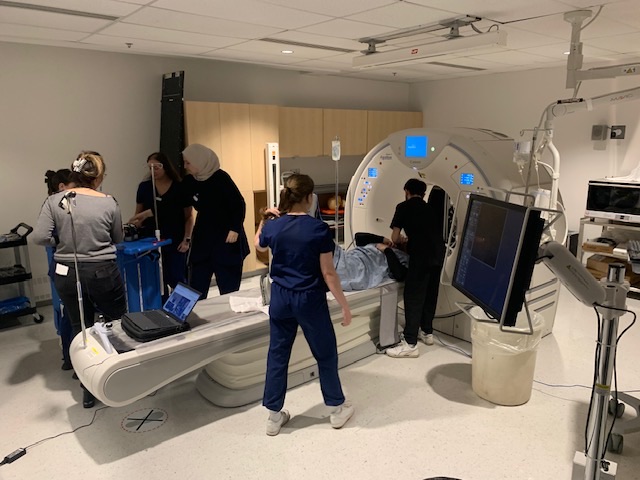
NEW activities for the 2024-2025 Academic year
Activity 10. Large scale Simulation on PDSP (Transfers) with first-year Nursing, Diagnostic Imaging, Radiation Oncology and Medical Ultrasound
Three separate simulation activities will be happening at once in three different settings: X-Ray room, CT-Room, and an Ultrasound assessment room. The nursing department will have students in all three patient transfer scenarios. We are currently preparing interprofessional learning objectives pulling from each discipline’s contributing courses and preparing the schedule of the day for each simulation activity. The simulation writing and planning has already started and will continue into the Fall 2024 semester. More information to come!
ECQ Grant to create an embedded IPE program: awaiting results of application
Next academic year we would like to embark on a larger project with the end goal of creating an embedded IPE program that would fit into each of the seven medical technology and social service disciplines. We plan to overlap all program matrixes and pinpoint where the 6 IPE competencies can be found within our program competencies, as well as when common program/course competencies occur across disciplines. Once these overlaps are flagged, a feasibility study will be done looking at the timing the competencies get covered and the potential barriers to creating an interdisciplinary learning opportunity. Teachers from each discipline, including a French instructor, would be released in the Winter Term to help brainstorm, ideate, and create new IPE learning opportunities based on our previous findings. We are crossing our fingers and hoping for a positive response from the ECQ team mid-July!
Concluding thoughts
The IPE team is very proud of what we have accomplished, and we are really excited for what’s to come! These learning experiences have the ultimate goal of helping our students be collaborative practice ready for their future workspaces. There is still room to grow, but we are on the right path! Thank you.
-Submitted by the IPE team


